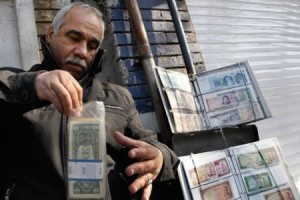The Drama of Iran’s Erratic Rial
By Kevan Harris
via the United States Institute of Peace
 What are the primary reasons that the Iranian rial has lost half of its value against the U.S. dollar in just one year? Iran’s currency was valued at about 10,000 rials to the dollar in the summer of 2011. It plummeted to more than 20,000 to the dollar in the summer of 2012.
What are the primary reasons that the Iranian rial has lost half of its value against the U.S. dollar in just one year? Iran’s currency was valued at about 10,000 rials to the dollar in the summer of 2011. It plummeted to more than 20,000 to the dollar in the summer of 2012.
Inflation in Iran’s economy has not been this bad since the end of the Iran-Iraq War or the economic crisis of the early 1990s, which also caused high inflation. The rial’s value began to slide rapidly at the beginning of 2012 after the United States announced new sanctions above and beyond the latest U.N. sanctions. The slide was due partly to the psychology of sanctions.
The government also went back to a tiered currency regime similar to what it had in the 1980s, during the Iraq-Iran War, and through the 1990s. Various types of imports and transactions had different exchange rates. Today, the official exchange rate is used for strategic imports such as food and medicine. That is another reason the price of rice did not go up a lot.
The price of chicken went up a lot, however, because Iran is not a socialist country. It cannot control the price of everything. Chicken farmers and wholesale buyers respond to market prices. The government capped the store price of chicken, but the price of chicken feed was going up because much of it is imported.
The state also stopped its phased subsidy reductions. It had planned to further cut longstanding subsidies for electricity, gasoline and utilities, but parliament told the president in the spring to continue the current level of subsidies. The president initially refused, but under parliamentary pressure has deferred any new price hikes. So U.S. and E.U. sanctions have forced the Islamic Republic to stop the subsidy reduction program that the International Monetary Fund and the Ahmadinejad government had been working on for years.
What roles have U.S. and international sanctions played in Iran’s currency drama? In July 2012, Parliamentary Speaker Ali Larijani said that only 20 percent of Iran’s economic problems were due to international sanctions. What is your assessment?
It is hard to put a number on what percentage U.S. and E.U. sanctions have on currency devaluation and inflation because both are produced by a combination of factors– what individuals do based on future uncertainty and the sometimes contradictory policies of the government.
The Central Bank has suggested that it may change the official exchange rate. What impact will that have? Will it solve the problem? Are there any side effects or dangers?
Some economists, including many in Iran, say the country needs a single rate. People make money playing the official and unofficial currency rates off each other. But the state does not have the luxury of unifying the rial’s value. So it is trying all sorts of stop-gap measures, which in the long term are harmful. They create opportunities for speculation. But the state, which is dealing in the short term, is in a double bind. Letting the official rate devalue would lead to such an inflationary burst that prices could go up even more.
En Español
The Latest
 From IPS News
From IPS News- By Sending Nuclear Weapons to UK, Could US be Fueling Nuclear Proliferation?
- Small Island States Fostering Effective Energy Transition To Achieve a Blue Economy
- Attacks on UNRWA Not About Its Neutrality, Says UNRWA Chief
- US Foreign Policy in Middle East Still Governed by Israeli Priorities
- Rich Nation Hypocrisy Accelerating Global Heating
- Seeking Justice for the Civilian Victims of the Syrian Civil War
- Who Should be the Next UN Leader?PART 7 FINAL
- Will a Two-State Solution include Palestine as a UN Member State?
- UN Live’s CEO Katja Iversen Talks About the Power of Popular Culture and ‘Sounds Right’
- Afghan Women’s Voices Stifled as Taliban Tightens Media Controls
- Online fundraising for IPS Inter Press Service at Razoo













